Stunning is the word that perhaps best describes the progress the LGBT community has made over the past year toward nationwide marriage equality. One year ago, 17 states plus the District of Columbia provided the freedom to marry for same-sex couples. Today, that number has grown to 36. Since the U. S. Supreme Court issued its landmark decision in United States v. Windsor in June 2013, more than 55 courts have ruled in favor of equality, with only four ruling against it. The Supreme Court announced on January 16 that it would hear cases challenging marriage discrimination in Michigan, Ohio, Kentucky and Tennessee. Arguments will take place through the end of April. Experts now look to the Supreme Court to issue a decision establishing marriage equality nationwide by the end of June 2015—just in time for Pride.
Recap of 2014
Last year began with what seemed unimaginable just recently: same-sex couples dashing to local clerks’ offices in Salt Lake City and other parts of Utah and getting married. It all took place after a federal district judge in late December 2013 struck down Utah’s marriage ban. Although the U. S. Supreme Court on January 6 stopped the Utah marriages temporarily while an appeal went forward, the spark that would ignite an extraordinary year for marriage equality had been lit. Just over a week later, a federal district court in Oklahoma ruled that state’s ban unconstitutional. Numerous courts across the country began ruling state laws that excluded same-sex couples from marriage unconstitutional. Same-sex couples began marrying in Oregon and Pennsylvania in May. One judge described the string of victories in the winter and spring of 2014 as an unprecedented phenomenon “throughout the federal court system.”
On June 25, the momentum intensified when the 10th Circuit Federal Court of Appeals agreed with the Utah district judge’s decision that Utah’s same-sex marriage ban was unconstitutional. Less than a month later, the 10th Circuit held that Oklahoma’s marriage ban was unconstitutional as well. Ten days after the Oklahoma decision, the 4th Circuit Federal Court of Appeals struck down Virginia’s marriage ban. On September 4, the 7th Circuit invalidated Indiana and Wisconsin’s bans. The decisions were significant because they came from powerful federal appellate courts, just one tier below the U. S. Supreme Court in the federal judicial system. Implementation of the decisions was stayed to give opponents of equality the opportunity to ask the Supreme Court to hear further appeals of the cases.
In October, nearly all legal observers expected the Supreme Court to announce that it would hear one or more of the cases in the current term. Instead, the Supreme Court on October 6 shocked court watchers by declining to take any of the cases, thereby letting the 4th, 7th and 10th Circuit decisions stand. Marriages began almost immediately in Indiana, Oklahoma, Utah, Virginia and Wisconsin. Because the decisions were circuit court decisions, they applied as legal precedent for other states in these circuits. Marriages began in Colorado (10th Circuit) and West Virginia (4th Circuit) soon thereafter. Other states in these circuits tried in vain to argue that the circuit precedents did not apply to them or otherwise attempted to create obstacles. But over the ensuing weeks, marriage equality came to the states of North Carolina and South Carolina (4th Circuit) and Wyoming and Kansas (10th Circuit).
The 9th Circuit Federal Court of Appeals added to the frenzy by overturning Idaho’s and Nevada’s marriage bans on October 7, just one day after the Supreme Court made its announcement that it would not hear the cases then before it. Despite efforts of equality opponents, marriages began in Idaho and Nevada and in the following weeks in Alaska, Arizona and Montana, also in the 9th Circuit.
Success in the South
On the other side of the country, marriage equality came to Florida in January 2015, with the 11th Circuit clearing the way even before it had heard arguments on an appeal of Florida’s law that remains pending before the court. Some states and equality opponents asked the Supreme Court to halt marriages temporarily until all appeals were exhausted, but the Supreme Court denied them.
During these months, many same-sex couples and members of the LGBT community were filled with a feeling of euphoria at finally having marriage equality in so many states—and a sense of disbelief at the pace of change taking place in some of the most unlikely states. Florida capped an astonishing gain of 19 states with marriage equality in one year—more in one year than all of the other years of the movement combined. The LGBT community and its friends were experiencing in a dramatic way the fruits of decades of hard work and dedication.
The drama continued in Alabama—the reddest of red states—as the fight for marriage equality began to look like a victory on January 23, 2015. That day, a U.S. District Court judge ruled in Searcy v. Strange that the state's ban on same-sex marriage is unconstitutional. Almost immediately, Alabama’s attorney general, Luther Strange, filed a motion to stop enforcement of the judge's ruling. Two days later, the ruling was stayed temporarily for 14 days, so that the state may seek a longer stay through the Eleventh Circuit Court of Appeals. But if equality wins in Alabama, as it has elsewhere, the Heart of Dixie will be the 37th U.S. state to allow same-sex marriage.
Where We’ve Been, Where We’re Going
Judges ruling in favor of equality during 2014 included those appointed by Presidents Carter, Reagan, George H.W. Bush, Clinton, George W. Bush and Obama. Many judges articulated the harm that marriage discrimination causes LGBT people and their families. One described the damage that the state marriage bans have inflicted on children of LGBT parents as “harrowing,” and denounced America’s history of “savage” discrimination against lesbian and gay people based on “hate.” Another federal judge said an often-quoted but discredited study, introduced to assert that same-sex marriage harmed children, was "entirely unbelievable and not worthy of serious consideration." Federal District Judge John E. Jones III, a George W. Bush appointee, summed it up perfectly in his opinion invalidating Pennsylvania’s marriage ban: “We are better people than what these laws represent, and it is time to discard them into the ash heap of history.”
On November 6, however, the momentum hit a speed bump. The 6th Circuit Federal Court of Appeals upheld same-sex marriage bans in Michigan, Ohio, Kentucky and Tennessee in an opinion the dissent described as “wholly fail[ing] to grapple with the relevant constitutional question(s).” The opinion was startlingly out of step with the consensus of more than 50 courts that have examined the issue over the past 18 months. The result of the ruling is that same-sex couples remain barred from marriage in those states, and those states may continue to refuse to recognize same-sex couples’ marriages performed in other states. The couples in these cases immediately asked the Supreme Court to review and reverse the 6th Circuit’s decision, and on January 16, the Court announced it would decide the cases. Briefing will be complete in April, with oral arguments likely in the last week of April. The Court asked the parties to address whether the liberty and equality guarantees of the United States Constitution prohibit a state from denying same-sex couples the freedom to marry, and whether states must recognize the marriages of same-sex couples performed in other states. Observers expect the Court to issue an opinion deciding the issue of national marriage equality in late June, when the Court traditionally announces its landmark decisions.
Equality advocates have cause for optimism about how the Supreme Court will rule because of the language of United States v Windsor, the groundbreaking 2013 decision striking down Section 3 of the Defense of Marriage Act (DOMA). The Court in Windsor did not invalidate DOMA on legalistic grounds; it described in no uncertain terms the human cost DOMA imposed on same-sex couples. The Court stated that DOMA’s purpose was “to impose a disadvantage, a separate status and so a stigma upon all who enter into same-sex marriages.” The law “instruct[ed] all federal officials, and indeed all persons with whom same-sex couples interact, including their own children, that their marriage [was] less worthy than the marriages of others.” Further, DOMA “humiliate[d] tens of thousands of children now being raised by same-sex couples.”
Tellingly, Justice Scalia, in his dissent, claimed the majority opinion would pave the way for national marriage equality. Many legal experts believe that the language of Windsor compels marriage equality, and that “heightened” judicial scrutiny should apply to laws that discriminate on the basis of sexual orientation and gender identity.
The struggle for marriage equality is part of the broader struggle for full LGBT equality—and a win for the freedom to marry is a win for the whole LGBT community. The Supreme Court said as much in 2003, in Lawrence v. Texas. The framers of the Constitution “knew times can blind us to certain truths and later generations can see that laws, once thought necessary and proper, in fact serve only to oppress. As the Constitution endures, persons in every generation can invoke its principles in their own search for greater freedom.”
John Lewis is the legal and policy director of Marriage Equality USA
State of Our Unions
After a stunning 2014, we are looking toward nationwide marriage equality this year.


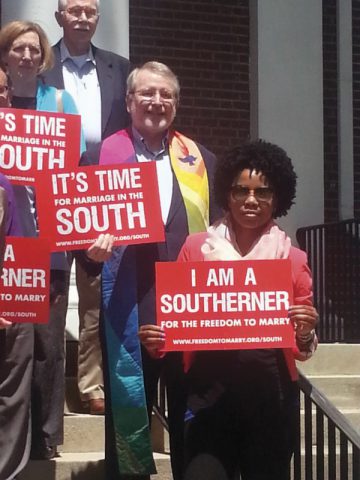
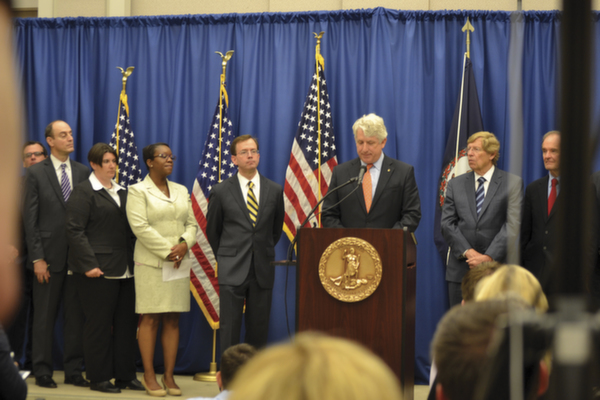
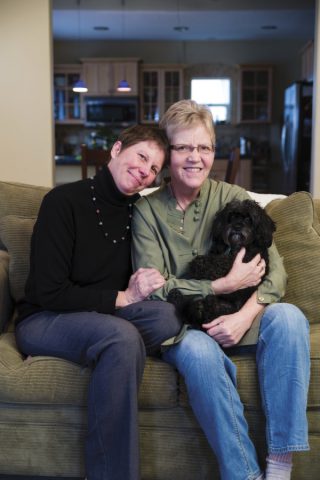
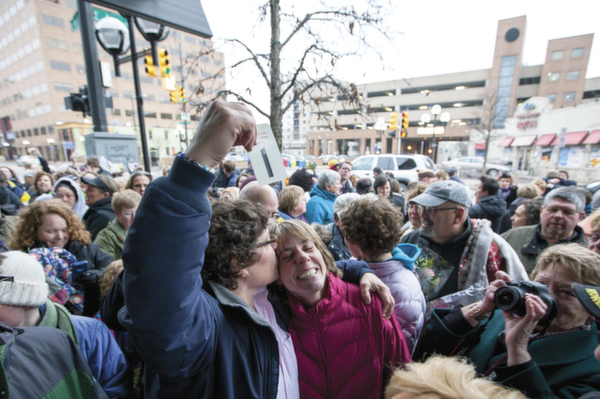
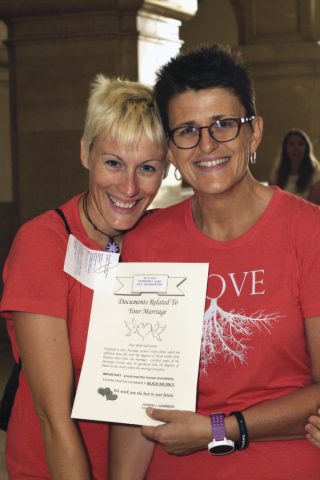
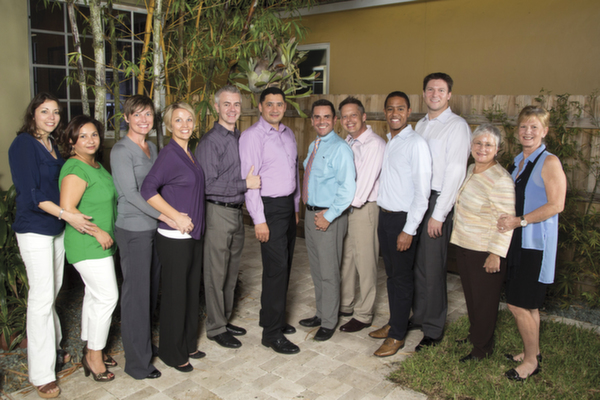
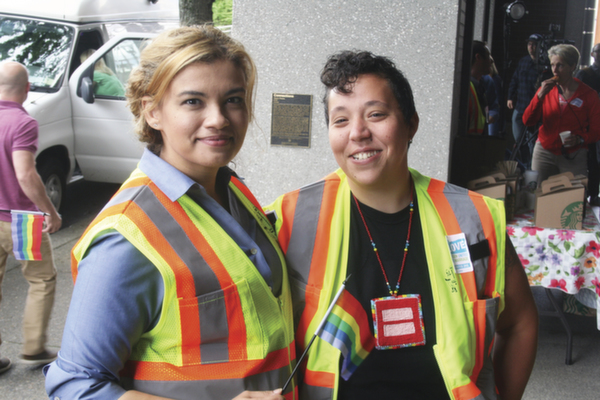

What Do You Think?